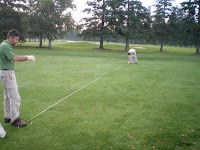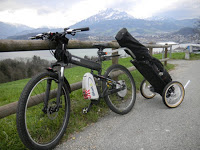 “We’ve just had the Olympics and many of the new sports facilities built for the Olympic Park in East London were commissioned with the strict policy of creating sustainable buildings. How often does this happen in golf? [There are] no policy directives from the governing bodies of golf. I guess it only occurs if the owners and or developers have an interest in the environment.” – Peter Gorse (Owner, Golf Refugees)
“We’ve just had the Olympics and many of the new sports facilities built for the Olympic Park in East London were commissioned with the strict policy of creating sustainable buildings. How often does this happen in golf? [There are] no policy directives from the governing bodies of golf. I guess it only occurs if the owners and or developers have an interest in the environment.” – Peter Gorse (Owner, Golf Refugees)For the past five years, the Environmental Institute for Golf (the philanthropic arm of the Golf Course Superintendent Association of America, or GCSAA) has been polling golf courses about their environmental stewardship. Why?
Well, because people complain that golf courses are killing the planet. For some, golf courses represent everything that is wrong with how humans treat the environment. First, vast tracts of land must be cleared to build the course (average course is 150 acres); then water, chemicals and fossil fuels are used to maintain it; and finally more fossil fuels are used (in the form of gas golf carts) to actually play on it.
Enter the Environmental Institute for Golf (of which Greg Norman is the Advisory Counsel Chair). Thus far, they’ve conducted surveys on water use; nutrient use; energy use; and are planning one on pest management soon (perhaps they should also consider adding a wildlife habitat study to boot).
Anyway, the information they’ve gathered is the first of its kind and they should be lauded for compiling it. And the results suggest things have been getting better – For example, 96% of golf courses have implemented at least one environmental improvement since 1996 and nearly half have implemented at least five improvements.
However, data also suggests courses continue to fertilize at a “slightly higher” rate than farmers fertilize some large-scale commodities in the U.S. In addition, golf courses used 30% more fossil fuels for maintenance per acre than a typical city-owned park in California. And one has to wonder how golf courses will stack-up with the use of pesticides, once that study has actually been conducted and released.
But for what it’s worth, the studies conducted by the Environmental Institute for Golf recommended golf courses seek alternative energy sources; proactively conserve water; and take steps to responsibly store and apply fertilizer (e.g. these studies show the golf industry is trying). Perhaps this research will set the standard for golf’s future policies and programs regarding the environment. As Scott J. Morrison (Sustainability Associate for the Golf Environment Organization) says: “Environmental certification programs support the need to measure the use of inputs and resources…after all you can’t manage what you don’t measure.”
And some environmental studies and programs seem to have already had an influence on the people that just might matter most:
“The new generation of Golf Superintendent is more focused on the environment than ever. Given programs like Integrated Pest Management (IPM), Permits to take Water (PTTW), expansion of environmentally sensitive areas and incoming scrutinizing of fertilizer and fertility programs…I think the real issue rests with owners, stakeholders and boards of directors…Many clubs have older owners and boards that only see the costs attached with becoming compliant instead of the long term positives that these programs bring to the plate.” – Andrew Hardy (Superintendent, Pheasant Run Golf Club and blogger at pheasantturf.wordpress.com)
Only time will tell if this new generation of golf supers will have a substantial impact on golf’s environmental stewardship, but as Mr. Gorse and Mr. Hardy both allude to, the ultimate responsibility lies with the governing bodies of golf (USGA and R&A) and course owners and developers. If the people in charge don’t care about the environment, then probably not much will change.
For now, the studies conducted by the Environmental Institute for Golf show courses are getting better when it comes to environmental stewardship. But by occupying far more land than a normal property owner, doesn’t it stand to reason that golf courses should not only get better, but really be the bellwethers of the community? Course owners and developers should set an example by providing the funding and resources necessary for golf superintendents to implement more eco-friendly options.
And there’s plenty more that can be done. Environmentalists, like Mr. Gorse, long for a day when all new golf facilities use compost toilets and worm turds to help fertilize the fairways and greens. In doing so, the rest of the community – from the leaders on down – might take notice and implement similar changes in town. Golf has something special going on in that the game is played in nature’s entire splendor. As such, golf needs to lead the way.
As Mr. Morrison puts it:
“Golf is doing a lot of great things, but we are not there yet, we have some difficult obstacles to cross and how we handle these will determine the environmental, economic and cultural dimensions of our future.“
Let’s forge our future and lead by example.



Some might think that building golf courses causes severe damage to our environment, but let’s stop and think: Would anyone prefer a large patch of open land be utilized as a smoldering landfill, rather than a verdant golf course? It may not be the best way to use the land but it sure isn’t the worst either.